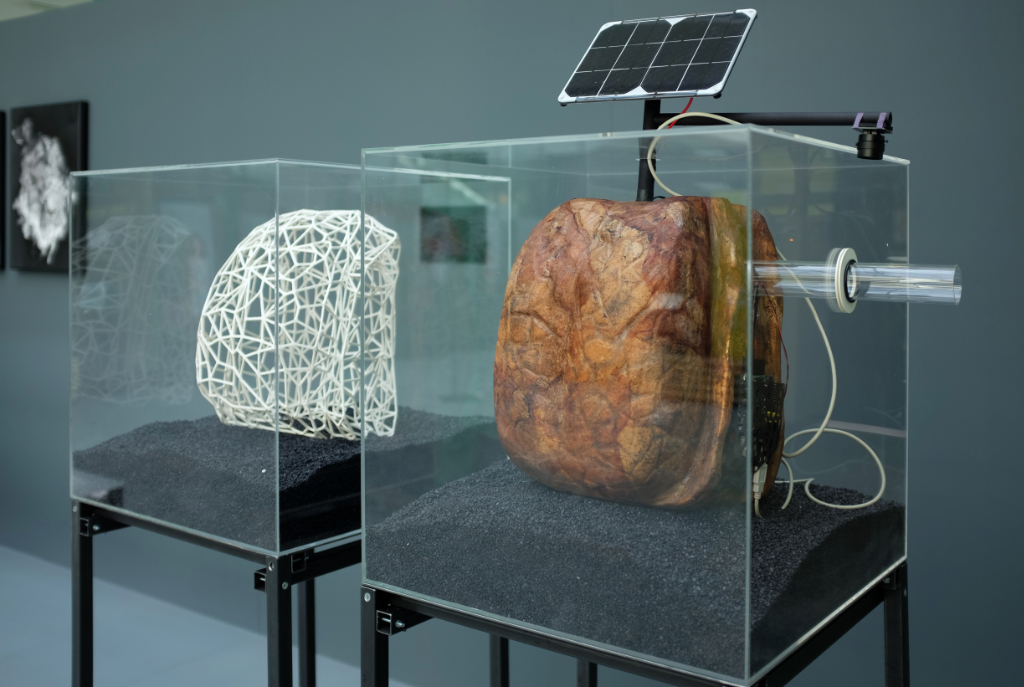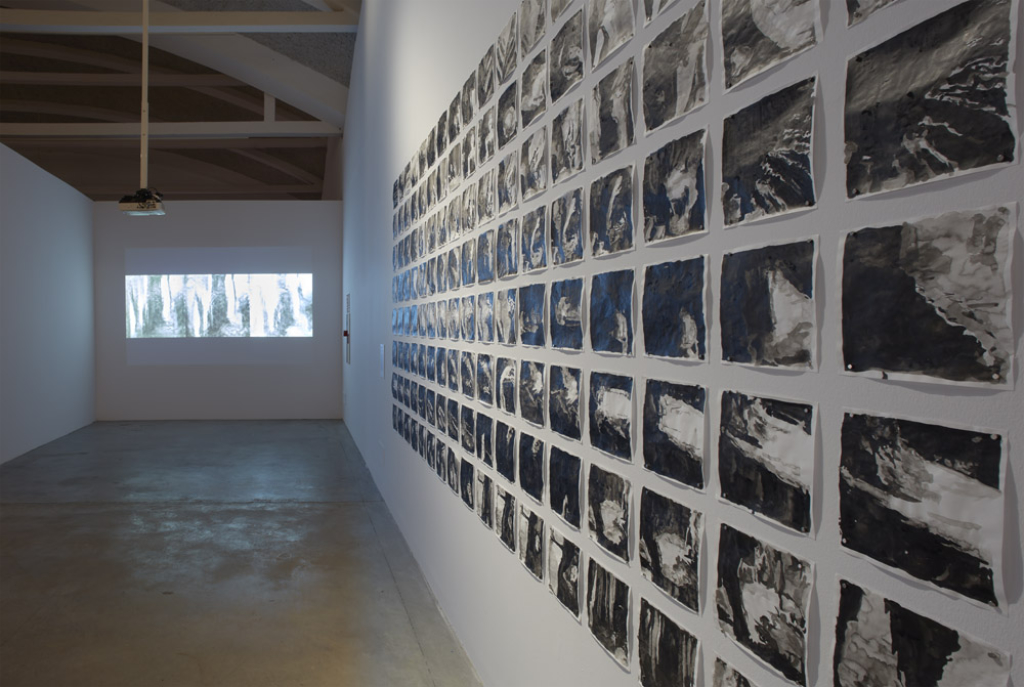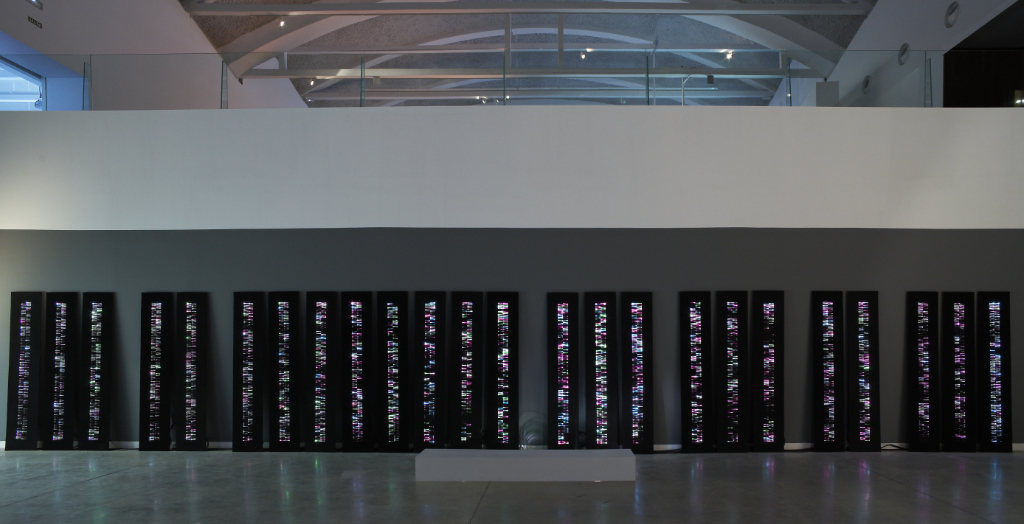Interview by Ana Prendes

Karin Ohlenschläger is a curator, art critic, and the artistic director of LABoral Centro de Arte y Creación Industrial in Gijón, Spain. With four decades of experience working on media art, Ohlenschläger’s curatorial practice has always been “the art-life discourse”, focusing on artistic projects that visualise processes, structures and relationships between experiences and knowledge, connected with the individual and collective sociopolitical circumstances.
Ohlenschläger studied art history and started to develop her curatorial career in the 1980s within Madrid’s performance art scene with the artist-run performance space Espacio P. This decade witnessed the first manifestations of computer art and early projects related to virtual reality. Interested in the performativity of digital art, Ohlenschläger curated her first exhibitions and programmes on computer art.
At the Museo Español de Arte Contemporaneo in Madrid, Ohlenschläger showcased the pioneering work of Peter Weibel, John Sanborn, and Fabrizio Plessi, among many others, which delved into the conceptual basis of media systems and information science.
In this ever-shifting context, Ohlenschläger started to dig into the dialogue between art, science, technology and society. In this transdisciplinary constellation, I also recognised the role of art to dynamise and act as a catalyst for the collective imaginaries, visions, and narratives related to the multiple challenges of the digital era and its impact on contemporary society.
In 2002, Ohlenschläger co-founded Media Lab Madrid – a citizens’ laboratory to produce open cultural projects, which co-directed until 2006. As artistic director of LABoral since 2016, Ohlenschläger has curated transversal and interdisciplinary exhibitions overseen by the same collaborative dynamics found in the works of the participating artists.
Her most recent show, When the butterflies of the soul flutter their wings (2020), showcased artistic projects that explore the structures and functions of mental processes within the fields of artificial intelligence and neuroscience
. Co-curated with Pau Waelder, D3US EX M4CH1NA.(2020) proposed a critical and creative reflection of AI’s impacts and consequences. Previously, Eco-visionaries (2018) interrogated how architecture, art and design react to a rapidly changing world beyond mainstream sustainability notions. Co-curated with Sabine Himmelsbach and Yvonne Volkart, Eco-visionaries toured internationally from MAAT in Lisbon, Matadero Madrid, to the Royal Academy of Arts London.
Having worked closely with pioneering artists, scientists, and technologists, Ohlenschläger has experienced and participated in evolving contemporary art practices to the current trends where artistic, scientific, technological and social experiences and knowledge converge.
Ohlenschläger explores new narratives and participatory dynamics in the evolving techno-scientific progress through her curating practice. I guide the visitor through certain questions to discover experiences and knowledge that art reveals to us, beyond the scientific data and technological devices used to realise each work.



As a curator and art critic, your work focuses on contemporary art and new technologies. Could you tell us a bit about your background and how your interest in the crossover of these disciplines came about?
After studying art history, I grew professionally with the Performance art of the 1980s, collaborating in Madrid with the first artist-run performance space promoted by multimedia and performance artist Pedro Garhel.
Known as Espacio P, it was one of the independent projects run by artists who worked based on Performance Art related to experimental video, photography, poetry, music, and film. That context also saw the first manifestations of computer art and very early projects related to Virtual Reality. In the early 1990s, Espacio P held the First Iberhack Meeting in Madrid with Wau Holland, the founder of Chaos Computer Club.
Interested in the performativity of digital art at that time, I curated the first exhibitions of computer art, including the retrospective Todo Fluye of Spanish works at the MNCARS (Madrid, 1995), the Muestra Internacional de Infoarquitectura at the exhibition hall of the MOPU-Ministerio de Obras Públicas (Madrid, 1997), and the international exhibition Arte Virtual- Realidad Plural at the Museo de Monterrey (Monterrey/Mexico, 1997/98).
In that decade, I delved into the conceptual basis of cybernetics and information science. That is how I began to appreciate the importance of the dialogue among art, science, technology and society. In this transdisciplinary constellation, I also recognised the role of art to dynamise and act as a catalyst for the collective imaginaries, visions, and narratives related to the multiple challenges of the digital era and its impact on contemporary society.
The current exhibition at LABoral Centro de Arte y Creación Industrial, When the butterflies of the soul flutter their wings, introduces us to the black box of biological and artificial neural networks. Could you tell us about the inspirations behind the curatorial narrative?
Neuroscience has always interested me. In fact, in 2008, I curated the exhibition banquete_nodos y redes (banquet_nodes and networks), which had as its conceptual framework the theory of networks, addressed by two great Spanish scientists: the father of modern neuroscience, Santiago Ramón y Cajal and the sociologist and author of The Rise of the Network Society (1996), Manuel Castells.
In this last decade, I turned my attention to advances in neuroscience research, driven by flagship projects such as BRAIN in the USA and the European Human Brain Project.
Taking advantage of LABoral’s participation as a partner of the European ARTificial Intelligence LAB, I thought it was the ideal moment to raise the concept of neural networks once again, both biological and artificial ones, on this occasion.
The title of this international exhibition on art, neuroscience and artificial intelligence is inspired by the words of Santiago Ramón y Cajal, who considered neurons to be butterflies of the soul whose fluttering wings would one day reveal the secret of mental life.
None of my previous exhibitions had taken such poetic license. In this case, it seemed appropriate to point out, among other things, that a scientist of the stature of Ramón y Cajal relied on the humanities –in his case especially poetry and drawing-, to advance in the edges of knowledge.
Could you tell us about the curatorial process? Are there any artists or artworks that you would like to highlight?
In the last two years, I have curated two major exhibitions related to artificial intelligence: Deus Ex Máchina, co-curated with Pau Waelder, and the present one, on my own. The first one highlighted a critical and creative reflection of art related to the impact of AI on virtually all areas of life, culture, politics, economics, labour, interpersonal relationships, and ecology.
The selection criteria were set following a dialogue between Pau and myself. We wanted to highlight pioneering proposals by artists such as Harold Cohen and Lynn Hershman and highlight contributions to gender, as shown in the installation of Caroline Sinders.
We exhibited projects related to the role and labour of artists in the future, raised by Guido Segni and Patrick Tresset; the impact of AI on global geopolitics narrated by Pinar Yoldas and the evolution of language and communication, seen in different ways in the installations of Jenna Sutela, Felix Luque and Jake Elwes.
In this second exhibition, When the butterflies of the soul flutter their wings, I focus on artistic projects that explore the structures and functions of mental processes such as perception, memory, learning, communication, creativity, and so on, investigated within the fields of AI and neuroscience, respectively.
When dealing with such a complex and innovative theme, I try to start from known concepts, such as the ones I have just mentioned, from a curatorial and mediation point of view. From there, I guide the visitor through certain questions to discover experiences and knowledge that art reveals to us beyond the scientific data and technological devices used in the realisation of each work.
This exhibition benefited from the scientific advice and interdisciplinary collaboration of the AIC Artificial Intelligence Centre and the INEUROPA Neuroscience Institute at the University of Oviedo. What role did these collaborations play in the development of the exhibition? How important are these entanglements for developing innovative cultural projects?
In my opinion, curatorial approaches of a transversal and interdisciplinary nature should be governed by the same collaborative dynamics with which the artists have previously developed their projects.
The Artificial Intelligence Center, AIC, and the Institute of Neuroscience, INEUROPA, act in an advisory role on the contents. They also provide a connection joining the different fields of scientific and artistic knowledge. And we jointly address the various educational and mediation contents. The same rigour must govern all of this in terms of the transmission of artistic, scientific, and technological knowledge.
Even so, the works chosen are not scientific visualisations. Their visions and narratives are juxtaposed with certain scientific accounts, especially when the work critically reflects scientific methods or facts.
I am also interested in building new communication flows between an art centre like LABoral and the University of Oviedo. As well as among the academic faculties. Thanks to this collaboration, scientists and engineers are discovering artistic practices they were unaware of as we broaden our scientific and technological horizons.
So, our projects foster dialogues that enrich us all: local and regional links between different cultural and educational institutions; relations between different fields of knowledge, which can be understood and transmitted through contemporary art and thought.
Finally, I think it is important to share these new dialogues between the sciences and the humanities– which are increasingly open to citizen participation– with a broad public. Only in this way will we be able to respond jointly to the multiple challenges and increasingly complex realities that shape our present.
At LABoral Art and Industrial Creation, the projects resulting from the Asturian Artistic Residencies in 2020 that supported Asturian artists have just opened. What role does LABoral play in supporting local and regional artistic communities? How do these programs benefit the artists and the cultural and artistic activity of the region?
LABoral has always understood its raison d’être to serve as a catalyst and mediating node on the regional, national, and international art scene. Art centres like ours, which are committed to current artistic practices – and to the construction of a cultural and artistic future that faces the challenges of the present – have a great responsibility to contribute to strengthening artistic and other transdisciplinary cultural networks in the region. All our activity corresponds to the network paradigm on which I have worked with special emphasis over the last twenty years and which forms part of the very DNA of the Art Centre.
You have been curating exhibitions on art and technology for almost 40 years. How has your practice evolved over the years?
My first exhibition project was in the 1980s as part of the organising team of the exhibition K18 Stoffwechsel, which ran parallel to Documenta 8 in Kassel in 1982. So, almost 40 years have passed. In a recent talk published in Spanish/English on the YouTube channel of Anilla Cultural Uruguay, I recently spoke about these four decades.
My guiding thread has always been the art-life discourse, with special emphasis on those artistic manifestations that have made visible processes, structures and relationships between experiences and knowledge connected with the different political and social contexts in which individual and collective life is inscribed.
I started with Performance art and the body, and then I continued exploring their technological and communicative externalisation transmitting and the transformation of our space-time parameters. The physical and digital world interactions led me to the dialogue among biological, social, technological, and cultural systems, and I continue here…
What can artists and arts institutions contribute to the discourse and practice of new technologies? Can their contributions impact our understanding and perception of these technologies?
Since the 1960s, artists and art institutions have contributed to critical thinking about new technologies and their humanisation. Some artists engaged in research and development of new technological devices, often before the industry had realised their potential.
Art has also raised highly critical reflections on the growing concentrations of power, making visible the new monopolies, the current mechanisms of control and surveillance, the loss of privacy, manipulation, and converting consumers into a market product.
Today more than ever, we need art and contemporary art institutions to make these bad practices visible, promote critical and creative thinking, and generate new horizons in the collective psyche and new narratives and participatory dynamics in the evolution of techno-scientific development.
You couldn’t live without…
Art-breathing! I discovered art at my maternal grandmother’s house. She had a large calendar with early 20th-century avant-garde artworks in the foyer of her home. Every year, at Christmas, she switched last year’s calendar for a new one with even more amazing works that were a real highlight for me then. Since I was a child, I felt that those images represented a world I wanted to belong to.
Although, in practice, my activities have nothing to do with painting, it would be very difficult for me to imagine life without this total immersion in art. Art’s visions and revelations inspire me -never better said-; they provide me with the oxygen my body and mind need to function. This art-breathing connects me to others; other minds and sensibilities, experiences, and knowledge unite us, differentiate us, and sometimes separate us.





